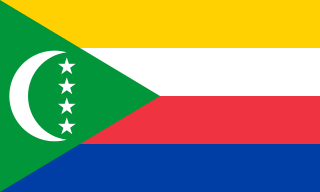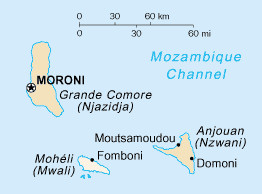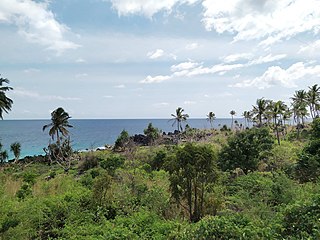
The wildlife of the Comoro Islands is composed of their flora and fauna.

The wildlife of the Comoro Islands is composed of their flora and fauna.
The mammalian diversity of the Comoros, like most other young volcanic islands, is restricted to marine mammals and bats. [1]
The country is home to 72 species of orchids.

The Comoros, officially the Union of the Comoros, is an archipelagic country made up of three islands in Southeastern Africa, located at the northern end of the Mozambique Channel in the Indian Ocean. Its capital and largest city is Moroni. The religion of the majority of the population, and the official state religion, is Sunni Islam. Comoros proclaimed its independence from France on 6 July 1975. A member of the Arab League, it is the only country in the Arab world which is entirely in the Southern Hemisphere. It is a member state of the African Union, the Organisation internationale de la Francophonie, the Organisation of Islamic Co-operation, and the Indian Ocean Commission. The country has three official languages: Shikomori, French and Arabic.

The Comoros archipelago consists of four main islands aligned along a northwest–southeast axis at the north end of the Mozambique Channel, between Mozambique and the island of Madagascar. Still widely known by their French names, the islands officially have been called by their Swahili names by the Comorian government. They are Grande Comore (Njazidja), Mohéli (Mwali), Anjouan (Nzwani), and Mayotte (Mahoré). The islands' distance from each other—Grande Comore is some 200 kilometers from Mayotte, forty kilometers from Mohéli, and eighty kilometers from Anjouan—along with a lack of good harbor facilities, make transportation and communication difficult. Comoros are sunny islands.

Anjouan is an autonomous volcanic island in the Comoro Islands in the southwestern Indian Ocean, part of the Union of the Comoros. It is known in Shikomori as Ndzuani, Ndzuwani or Nzwani, and, until the early twentieth century when the name fell out of general use, in English as Johanna. Historically it was also called Hinzuan or Hanzoan.

The cuckoo-roller or courol is the only bird in the family Leptosomidae, which was previously often placed in the order Coraciiformes but is now placed in its own order Leptosomiformes. The cuckoo-roller is at the root of a group that contains the Trogoniformes, Bucerotiformes, Piciformes, and Coraciiformes. Despite its name, the Cuckoo-roller does not share close evolutionary origins with cuckoos or rollers at all.

Moroni is the largest city, federal capital, and seat of the government of the Union of the Comoros, a sovereign archipelago nation in the Indian Ocean. Moroni means "at the river". Moroni is the capital of the semi-autonomous island of Ngazidja, the largest of the three main islands of the republic. The city's estimated population in 2003 was 41,557 residents. Moroni, which lies along the Route Nationale 1, has a port and several mosques such as the Badjanani Mosque.

The Comoro Islands or the Comoros are an archipelago of volcanic islands situated off the southeastern coast of Africa, to the east of Mozambique and northwest of Madagascar. The islands are politically divided between the Union of the Comoros, a sovereign country, and Mayotte, an Overseas Department of France.

Mohéli, also known as Mwali, is an autonomously-governed island that forms part of the Union of the Comoros. It is the smallest of the three major islands in the country. It is located in the Indian Ocean off the coast of Africa and it is the smallest of the four major Comoro Islands. Its capital and largest city is Fomboni.

Mount Karthala or Karthola is an active volcano and the highest point of the Comoros at 2,361 m (7,746 ft) above sea level. It is the southernmost and larger of the two shield volcanoes forming Grande Comore island, the largest island in the nation of Comoros. The Karthala volcano is very active, having erupted more than 20 times since the 19th century. Frequent eruptions have shaped the volcano's 3 km by 4 km summit caldera, but the island has largely escaped broad destruction. Eruptions on April 17, 2005 and May 29, 2006 ended a period of quiet.
This article is one of a series providing information about endemism among birds in the world's various zoogeographic zones. For an overview of this subject see Endemism in birds.
The Karthala scops owl, also known as the Grand Comore scops owl or Comoro scops owl, is a small scops owl endemic to the island of Grande Comore in the Comoro Islands.

Frances's sparrowhawk is a small bird of prey. The nominate subspecies, A. f. francesiae, is endemic to Madagascar, and the other subspecies are found in the Comoro Islands. The Anjouan sparrowhawk, also known as the Anjouan Island sparrowhawk, Ndzuwani goshawk or Joanna Island goshawk, was thought to be extinct until searches in the 1980s and in 2005 confirmed that it is still extant.

Dypsis is a genus of flowering plants in the family Arecaceae. They are slender, evergreen palms with yellow flowers carried in panicles amongst the pinnate leaves. Many Dypsis species have aerial branching, a rare growth habit among palms. Some have marcescent leaves that remain attached after death and trap litter for nutrients.

The dimorphic egret is a species of heron in the family Ardeidae. It is found in Comoros, Kenya, Madagascar, Mayotte, Seychelles, and Tanzania.
The Grande Comore bulbul is a species of songbird in the bulbul family, Pycnonotidae. It is found on the Comoro Islands. Its natural habitat is subtropical or tropical moist montane forests. Until 2011, the Moheli bulbul was considered as a subspecies of the Grand Comoro bulbul. Alternative names for the Grande Comore bulbul include the Comoro bulbul and Grand Comoro black bulbul.

The Comoro blue pigeon is a species of bird in the family Columbidae. It is endemic to the Comoros and the coralline Seychelles. It is rated as a species of near threatened on the International Union for Conservation of Nature Red List of Endangered Species.

The Comoro olive pigeon, also known as the Comoros Rameron pigeon or simply the Comoro pigeon, is a species of bird in the family Columbidae. It is found in Comoros and Mayotte. It is becoming rare due to habitat loss.

Mimusops is a genus of plants in the family Sapotaceae described as a genus by Linnaeus in 1753.

The following outline is provided as an overview of and topical guide to Comoros:

The Comoros forests is a terrestrial ecoregion which covers the Comoro Islands, which lie in the Mozambique Channel between Madagascar and East Africa. These include four main islands: Grande Comore, Anjouan and Mohéli, of the Union of the Comoros, and Mayotte, a department and region of France.